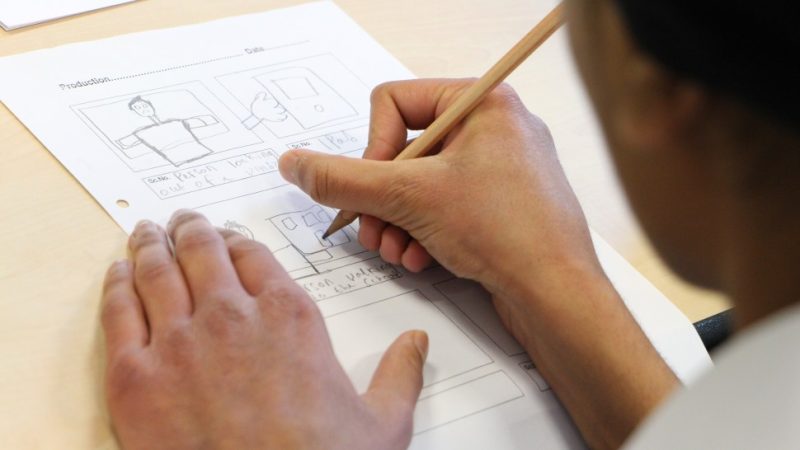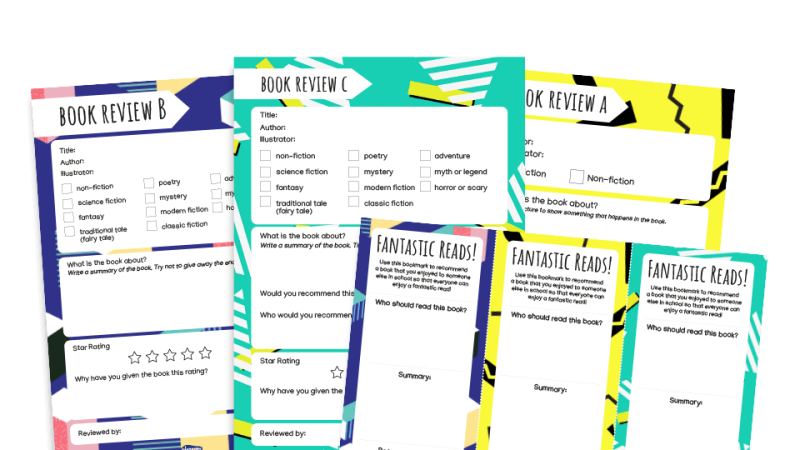KS1 Book Topic: Explore Conflict, Compromise And Compassion With Brianne Farley’s Secret Tree Fort

Meet two sisters with disparate views on the power of imagination and the tangibility of the real

“I have a secret tree fort, and you’re not invited!” In this true-to-life, warm and appealing picturebook, two siblings have contrasting views about what they should do outside. “Play with me,” begs the younger one, but the older girl just wants to read. “Fine!” says the little one, eventually.
The glories of this fort are numerous. But not even the water-balloon launcher (for keeping pirates at bay) or winch (for hauling snacks away from monsters) can attract the older girl’s attention. Nothing works, in fact, until the little one decides the fort is made of sweets. And suddenly on a double spread that gets to the heart of sibling quarrels everywhere, they’re arguing.
It’s only when the younger one admits to having made the whole thing up that the older girl can give way, too. The fort might not exist, she says, but “maybe we just need to build it”. So they do.
Powerful ideas
Secret Tree Fort is a gem, with lots to enjoy, laugh about and unpack. It’s unusual to find a picturebook addressing a sibling relationship with such a sure touch as this one; these girls are feisty, with richly imagined inner worlds. Their approaches to life may be different, but they’re not one-sided. Imagination and action coexist quite comfortably for both of them, and they feel very real.
This is a book that offers “small, wonderfully specific insights into childhood imaginings, feelings and frustrations” (Kirkus Reviews), and it’s this emotional integrity along with Secret Tree Fort’s funny, fresh inventiveness, that makes it work so well at KS1.
Sharing the book
There are many ways you can introduce this text, from chatting about dens and treehouses, to drama games designed to prepare children for a deeper engagement with the story. The ‘imagination or reality’ activity below, for example, could be used in this way, or you could explore quarrels and how your children feel about them.
However you approach it, make sure you’ve got time for lots of book talk afterwards.
Don’t stop make-believin’
Talk about imaginary games. What do you play, and why? Who or what inspires your games – a film, a person, a book? What’s good about an imaginary game? Are there similarities between the games played by different children in your class? What kind of imaginary games do you think children play in other countries?
Getting ‘lost in a book’
Who knows what it’s like to be ‘lost in a book’? Can you tell us about it? Which books have you enjoyed being ‘lost inside,’ and why? Which books would you recommend to the big sister in this book?
Who knows (or can imagine) what it’s like to watch someone who’s ‘lost in a book’? Could this make the watcher feel left out? Why? The little sister doesn’t seem to like reading. Which books would you recommend to her, and why?
Reading the jacket
What do the cover and title page of this book tell you about it – and in particular, the characters? Look at the odd things in the tree. Why are they there? A book jacket is meant to attract our attention and persuade us to read the book. Does this book jacket work, do you think? Why (or why not)? And if you don’t like the jacket, how would you redesign it to make it better?
BUILDING ON YOUR STORYBOOK EXPERIENCE
No, it doesn’t! Yes, it does!
Use the ‘argument’ spread to start a discussion. How do the girls feel in this picture? How can you tell? What do you think about the way the illustrator has used words to form the background of each picture?
If you didn’t know the story, what could this argument be about? Discuss possibilities and make a list, then choose one to explore. In pairs, role play your argument in a confrontational way, just like these girls. How does it feel? Is this a good way to resolve an argument? How else could you resolve it? Try role-playing your argument again, using a different approach. Then write some advice for people in school on how to resolve an argument.
Storybuilding
Look carefully at the spread showing the invaders circling the tree (there’s even a basket for snacks). What kind of day is it? Do you think it’s warm or cold? What are the girls doing, and why? What does the action look like from their perspective? What can they hear, and how do they feel about what’s going on? What do the invaders want, and what are they thinking?
In a large, clear space, put children in groups and ask them to role play the four invaders. Allow time for exploration and discussion. Then ask each group to freeze-frame the picture, copying the characters’ positions and expressions as far as possible.
On a given signal, bring the characters to life. What will they do and say to each other? What’s going to happen next?
Use the experience to kick-start story-writing based on this illustration.
Create a secret flag language
Using the pictures to inspire you, design some flags that you could use to communicate with someone at a distance. Make them using painted card or fabric then test them out. How far can you go before you stop being able to see them clearly?
Design a water-balloon launcher
This tree fort has a water-balloon launcher. Challenge Year 2 (or adapt the activity for younger children by working together as a class, so that you can scribe for them and model the approach) to design and build a launcher of their own, using recycled card, fabric offcuts, wood and other materials, together with rubber bands and string. Make sure your testers wear eye protection, just like real engineers! Designs could explore the catapult model used in the book, or other approaches – check out pictures of medieval siege machines for ideas.
Keep notes and drawings of the changes you make as you progress. Encourage trying out different models (using a tennis ball in place of a water bomb) then stage a ‘grand water-balloon trial’ of the final prototypes outside.
How will you measure the distance travelled by each balloon? Don’t forget to record your findings and take photographs, so you can prepare a report. Use your data to create a table showing how far each balloon travelled, then write about your investigation and illustrate it.
Fact or fiction?
To explore the conflict between imagination and reality that drives this book, hide a plastic crown inside a beautifully wrapped box. Show the box to your class, explaining there’s a special crown inside, then pass it round. What does the crown look like? What will it feel like? Who could it belong to?
With much ceremony, appoint someone to open the box. Pass round the crown, and wait for your children to respond. It probably won’t match their expectations, but those who are disappointed may take longer to react, so give them time. You want honest reactions, so you may need to ask some open-ended questions to get things rolling: I wonder why somebody might feel disappointed by this crown? Does anyone here feel that way? Can anybody explain?
When something’s just an idea, then anything is possible. But once it’s there in front of you, it’s fixed – meaning that different personality types are likely to respond differently to this exercise. Hands-on, active children will be happier once the crown has been unwrapped and they can engage with the reality. Open-ended, imaginative thinkers may find they preferred the crown before it was unwrapped.
Keep the discussion light-touch, then share the book again and invite responses from your class. Allow children to refer to the crown exercise independently – it may take a while before connections are made. If nobody brings it up, you can ask ‘Why did we play that game with the crown before we read this book? Can anyone see a connection?’
Just like your class, the girls in the book are very different. One likes to sit quietly, reading, and the other prefers to be busy and active – but the active girl also has a great imagination, and in the end, it’s the girl who’s reading who suggests a way to make the secret treehouse real.
What do your class think the real tree fort will be like, once the girls have built it? Will it be better or worse than the imaginary fort? Why?
Secret dens
What would your ideal den look like? Using big sheets of paper and marker pens, design your den and annotate it with notes showing all its features. You can be as imaginative – or realistic – or as you like.
In pairs, share your designs. Then choose the three best features from your partner’s drawing and tell the rest of the class about them. Together, create a list of all the chosen features and think of some really good words to describe them. Use your words and ideas to help you write a description of a secret den – the one you designed earlier, or something different.
Taking it further
Go into the park or woodland and search for the best locations for treehouses and dens, then have a go at building some. They don’t have to be full-size – if your outdoor access is limited, you could design and build a den for a teddy or a mouse (or even a ladybird).
If you want to run a den-building challenge, why not invite parents and grandparents to help? They’ll enjoy talking about the dens they built as children and the games they played in them. When you’ve finished your constructions, you can create a book of reminiscences.
IF YOU LIKED THIS, TRY:
On Sudden Hill by Linda Sarah and Benji Davies Roxaboxen by Alice McLerran and Barbara Cooney Virginia Wolf by Kyo Maclear and Isabelle Arsenault The 13-Storey Treehouse by Andy Griffiths and Terry Denton The Magic Faraway Tree by Enid Blyton
GIMME SHELTER
Whether it’s for an imaginative lesson or raising money for charity, building a den is a fantastic experience for pupils There’s something affecting about a child’s desire to make a den. They’re spaces that can be controlled: secret spaces, from which the world can be observed – or escaped entirely.
Dens are an almost universal human experience, linking us through time and across continents, which makes them an ideal focus for intergenerational projects. There’s some robust and well-researched practice to support den-building: to find out more, see this playworker’s guide to dens and forts.
If you’d like to learn about Save the Children’s Den Day, including access to the Dengineer STEM Challenge, see denday.savethechildren.org.uk and check out Den Day on Pinterest for inspiration.
Carey Fluker Hunt is a freelance writer, children’s book ambassador and creative consultant.
Main Image Copyright © 2016 Brianne Farley, from Secret Tree Fort by Brianne Farley. Reproduced by permission of Walker Books Ltd, London SE11 5HJ. www.walker.co.uk












